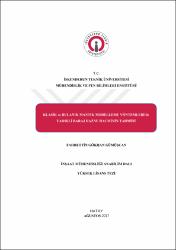| dc.contributor.advisor | Üneş, Fatih | |
| dc.contributor.author | Gümüşcan, Fahrettin Gökhan | |
| dc.date.accessioned | 2020-12-22T11:14:08Z | |
| dc.date.available | 2020-12-22T11:14:08Z | |
| dc.date.issued | 2017 | en_US |
| dc.date.submitted | 2017 | |
| dc.identifier.citation | Gümüşcan, F. G. (2017). Klasik ve bulanık mantık modelleme yöntemleri ile Yarseli baraj hazne hacminin tahmini. (Yüksek Lisans Tezi). İskenderun Teknik Üniversitesi / Mühendislik ve Fen Bilimleri Enstitüsü, Hatay. | en_US |
| dc.identifier.uri | https://hdl.handle.net/20.500.12508/1542 | |
| dc.description.abstract | Baraj hazne hacim değişimlerinin belirlenmesi; baraj haznesi yönetimi, hidrolik yapıların tasarımı, hidroelektrik enerji üretimi, taşkın zararları azaltılması, baraj rezervuarında navigasyon (iç su yolu taşımacılığı) olarak, rezervuarlardaki su kalitesi yönetimi ve baraj güvenliği için önemlidir. Bu çalışmada, ilk kısımda baraj haznesi hacim değişim tahminleri, çoklu lineer regresyon (ÇLR) ile bulanık mantık (BM) metodu kullanılarak araştırılmıştır. İkinci kısımda baraj haznesi hacim miktarları, zaman serileri kullanılarak otoregresif (AR) ve bulanık mantık (BM) modeli performansları araştırılmıştır. Yarseli Barajına ait yaklaşık oniki yıllık 4019 günlük veriden, 3015 günlük veri eğitim aşamasında, 1004 günlük veri test aşamasında değerlendirilmiştir. İlk kısımda, günlük göl hacmi (GGH) tahmini için günlük yağış yüksekliği (GYY), günlük göle gelen su miktarı (GGGSM), günlük buharlaşan su miktarı (GBSM), günlük dereye bırakılan su miktarı (GDBSM) ve günlük sulama suyu sarfiyatı (GSSS) ölçüm verileri kullanılmıştır. Değişkenler arasındaki ilişkiyi belirlemek için geçmişte sıklıkla kullanılan klasik istatistiksel yöntemlerden olan çoklu lineer regresyon yöntemi (ÇLR) kullanılarak, bulanık mantık (BM) yöntemi karşılaştırılmıştır. Değerlendirmeler sonucunda BM yönteminin daha yüksek korelasyon (R) ve düşük hata miktarlarına sahip olduğu tespit edilmiştir. İkinci kısımda, geçmiş günlük göl hacmi (GGH) ölçümlerine dayalı zaman serileri üretilerek, bu seriler için otoregresif (AR) ve bulanık mantık (BM) modelleri oluşturulmuş ve günlük göl hacmi tahmini yapılmıştır. Otoregresif modeller (AR) ile BM model sonuçları karşılaştırıldığında, birbirleri ile uyumlu sonuçlar vermiştir. AR ve BM model sonuçlarına göre her iki yöntem en yüksek R katsayısını sağlamıştır. BM model sonuçlarının, çok az da olsa, diğer modellere göre daha düşük ortalama karesel hata (MSE) ve yüksek korelasyon (R) ile çok iyi sonuçlar verdiği tespit edilmiştir. Anahtar Kelimeler: Baraj hazne hacmi, bulanık mantık, otoregresif model, çoklu lineer regresyon | en_US |
| dc.description.abstract | Determination of reservoir volume fluctuations is important for the management of dam reservoir, design of hydraulic structures, production of hydro-electric energy, reduction of flood damages, navigation (interior waterway transportation) in the dam reservoirs, water quality management in reservoir and the dam safety. In this study, the estimations of the volume fluctuations of the dam reservoir were investigated using Multiple Regression (MLR) and Fuzzy Logic (FL) method in the first section. In the second part, the autoregressive (AR) and Fuzzy Logic (FL) model performances of the volume amounts of dam reservoir were investigated by using time series. 3015 daily data were assessed in training phase and 1004 daily data were assessed in the test phase from 4019 daily data, approximately 12 years, of the Yarseli dam. In the first part, to forecast daily dam lake volume (GGH); daily rainfall height (GYY), daily amount of water flowing into the lake (GDBSM), daily amount of evaporated water (GBSM), the daily amount of water released into the river (GDBSM) and daily irrigation water consumption (GSSS) measurement data were used. The Fuzzy Logic (FL) method was compared using the Multiple Linear Regression Method (MLR), which is one of the classical statistical methods that was frequently used in the past to determine the relationship between variables. As a result of the evaluations, the BM method has been found to have higher correlation (R) and lower error rates. In the second part, time series based on past daily lake volume (GGH) measurements were produced, and Autoregressive (AR) and Fuzzy Logic (FL) Models were created for these series and daily lake volume estimation was conducted. When the autoregressive models (AR) and the FL model results are compared, they gave consistent results with each other. According to the AR and FL model results, both methods provided the highest R-coefficient. It has been found that the FL model results give very good results at the least with very low mean square errors (MSE) and high correlation (R), compared to other models. Keywords: Dam reservoir volume, fuzzy logic, autoregressive model, multiple linear regression | en_US |
| dc.language.iso | tur | en_US |
| dc.publisher | İskenderun Teknik Üniversitesi / Mühendislik ve Fen Bilimleri Enstitüsü / İnşaat Mühendisliği Anabilim Dalı | en_US |
| dc.rights | info:eu-repo/semantics/openAccess | en_US |
| dc.subject | Baraj hazne hacmi | en_US |
| dc.subject | Bulanık mantık | en_US |
| dc.subject | Otoregresif model | en_US |
| dc.subject | Çoklu Lineer Regresyon | en_US |
| dc.subject | Dam reservoir volume | en_US |
| dc.subject | Fuzzy logic | en_US |
| dc.subject | Autoregressive model | en_US |
| dc.subject | Multiple linear regression | en_US |
| dc.title | Klasik ve bulanık mantık modelleme yöntemleri ile Yarseli baraj hazne hacminin tahmini | en_US |
| dc.title.alternative | Estimation of Yarseli dam reservoir volume with classical and fuzzy logic modeling methods | en_US |
| dc.type | masterThesis | en_US |
| dc.contributor.department | Mühendislik ve Fen Bilimleri Enstitüsü | en_US |
| dc.relation.publicationcategory | Tez | en_US |
| dc.contributor.isteauthor | Üneş, Fatih | |
| dc.relation.index | İndeks Bilgisi Yok | en_US |
















